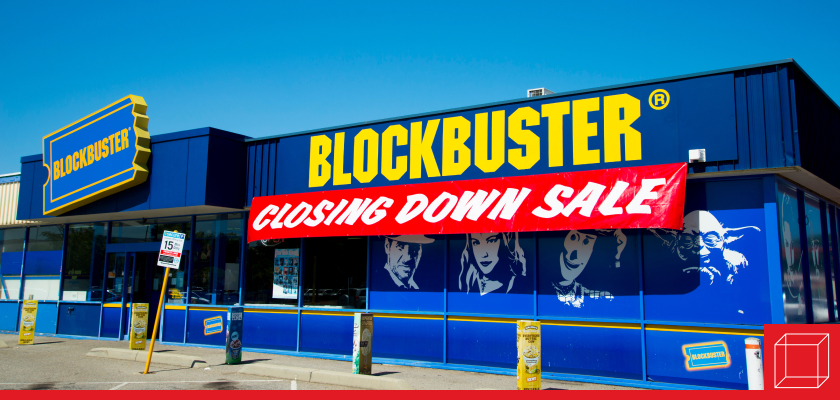Why Do Big Companies Fail? | September 2023
Giant companies like Amazon and Walmart may seem too big to fail, but if history repeats itself, which it often does, no company is safe at the top.

Many big companies have failed or been overtaken by competitors. Giant companies like Amazon and Walmart may seem too big to fail, but if history repeats itself, which it often does, no company is safe at the top. Kodak, Blockbuster, Sears, Yahoo, and IBM are examples of companies that failed to maintain their lead. Businesses are upended by disruptive innovation, shifts in consumer behavior, poor management, and many other factors.
Disruptive innovation
Disruptive innovation is often to blame for corporate failures. This is when new entrants introduce goods, services, and ways of doing business that are typically more affordable or accessible than existing offerings or address the needs of overlooked customers. Disruptive innovation can upend established competitors and create new markets. Spotify changed the way we listen to music, Tesla accelerated the adoption of electric vehicles, and Uber challenged the taxi industry.
The pace of disruption is increasing, threatening big companies. For instance, OpenAI, the company behind generative artificial intelligence (AI) chatbot ChatGPT, has disrupted the tech industry and the world of AI. Google, the number one search engine, has scrambled to catch up. Microsoft, on the other hand, has positioned itself as a disrupter, partnering with OpenAI rather than fighting against it. Google earns $160 billion a year from search and advertising, so a fundamental disruption to the way people search could be catastrophic.
Companies that fail to innovate are unlikely to maintain their lead over competitors. A prime example of a company losing its lead is Blockbuster, a video rental company and a former leader in the at-home entertainment industry. It was dethroned by Netflix, a DVD-by-mail company that is now a streaming giant. Today, Netflix is the biggest streaming service provider, but even its dominance is threatened by rising competition.
Consumer behavior
In the real world, when businesses fail or lose their lead, there is generally more than one factor to blame. Consider the world of retailing. Sears was the top retailer for decades but was overtaken by Walmart and Kmart. It is possible Amazon will overtake Walmart one day. But it wasn’t just innovation (or a lack of innovation) that crushed the retail giant.
Sears, which started as a mail-order watch and jewelry company, became a supply house, rising in popularity thanks to its catalogs which helped connect rural areas with the company’s low-cost merchandise. In 1925, Sears opened its first retail store at a time when cars were becoming increasingly popular, shifting its focus from rural customers to suburban customers.
Poor management
Sears’ sales soared through the 1970s. In the 1980s and 1990s, Sears made major changes such as taking away control from store managers to improve continuity, eliminating sales commissions, expanding into financial services, discontinuing its catalog, and expanding its in-store services. By this point, Sears had fallen behind both Walmart and Kmart.
Sears merged with Kmart and sales rose, but the shift to online retailing was well underway in the early 2000s. As Sears struggled against Walmart and Amazon, employees blamed high-level managers, namely the chief executive officer, for poor management. In 2018, Sears filed for bankruptcy. Today, there are less than a dozen Sears stores remaining.
As this example shows, there are often many factors that contribute to a company’s downfall. Companies must find a balance between doing what they know and trying new things. To stay ahead, established competitors must develop new ideas, select the best ideas to develop, and allocate the resources necessary to scale these ideas.
In the Classroom
This article can be used to discuss the nature of competition (Chapter 1: The Dynamics of Business and Economics) and the product life cycle (Chapter 12: Dimensions of Marketing Strategy).
Discussion Questions
What is disruptive innovation? Provide an example.
Why is AI a threat to Google?
What factors contributed to the fall of Sears?
This article was developed with the support of Kelsey Reddick for and under the direction of O.C. Ferrell, Linda Ferrell, and Geoff Hirt.
Sources
Alyson Shontell, "Fortune’s Global 500 Is Proof That Even the Biggest Companies Can Be Dethroned," Fortune, August 2, 2023, https://fortune.com/2023/08/02/global-500-worlds-largest-companies-revenue-walmart-saudi-aramco-alphabet/
Erin McDowell and Avery Hartmans, "The Rise and Fall of Sears," Business Insider, December 19, 2022, https://www.businessinsider.com/rise-and-fall-of-sears-bankruptcy-store-closings
Stanford Graduate School of Business, "Why Great Businesses Fail," YouTube, November 1, 2019, https://www.youtube.com/watch?v=sNLC7wbXEl0



